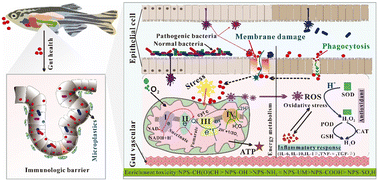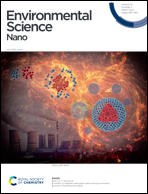Dysregulation of gut health in zebrafish by differentially charged nanoplastic exposure: an integrated analysis of histopathology, immunology, and microbial informatics†
Abstract
Differentially charged nanoplastics (NPs; different surface functional groups) engendered by plastic aging widely exist in the water environment, yet less is known about their bio-enrichment characteristics and toxicity effects. In this work, zebrafish exposure to NPs (200 nm; 50 μg L−1) for 18 days was implemented to simulate and investigate gut dysfunction caused by differentially charged nanoplastic intake by combining histopathology, RT-qPCR of target genes, metabolomics, and microflora 16S rRNA sequencing. The results indicated that NP intake induced gut inflammatory lesions (e.g., swelling and rupture of goblet cells, movement of giant cells to the damaged area of gut mucosa, and villi rupture and sparse), electron transfer disorder and energy metabolism inhibition during mitochondrial oxidative phosphorylation (OXPHOS) (down-regulation of genes mt-nd1, ndufs4, and cox1), oxidative stress, and up-regulation of pro-inflammatory factors (genes IL-1β, IL-6, and TNF-α) as well as pathway disorders associated with glycolipid metabolism. Besides, NP intake distinctly caused gut microflora disorder, especially the enrichment of pathogenic bacteria (e.g., Catenibacillus, Coprobacillus, and Butyricimonas) associated with gut diseases such as ulcer, food poisoning, and constipation. Most importantly, degrees of these adverse effects evidently depended on the aggregation behavior of differentially charged nanoplastics in the water environment, the adsorption of gut mucosa, and cell endocytosis. Moreover, the microbial biomarkers affecting indicators associated with gut health after NP exposure were determined by co-occurrence network and correlation analysis. Overall, these results revealed how NP intake causes growth inhibition, nutritional disorders, and increased oxygen consumption, and the migration abilities of NPs from the water environment to gut tissues decided their bio-enrichment toxicities.



 Please wait while we load your content...
Please wait while we load your content...